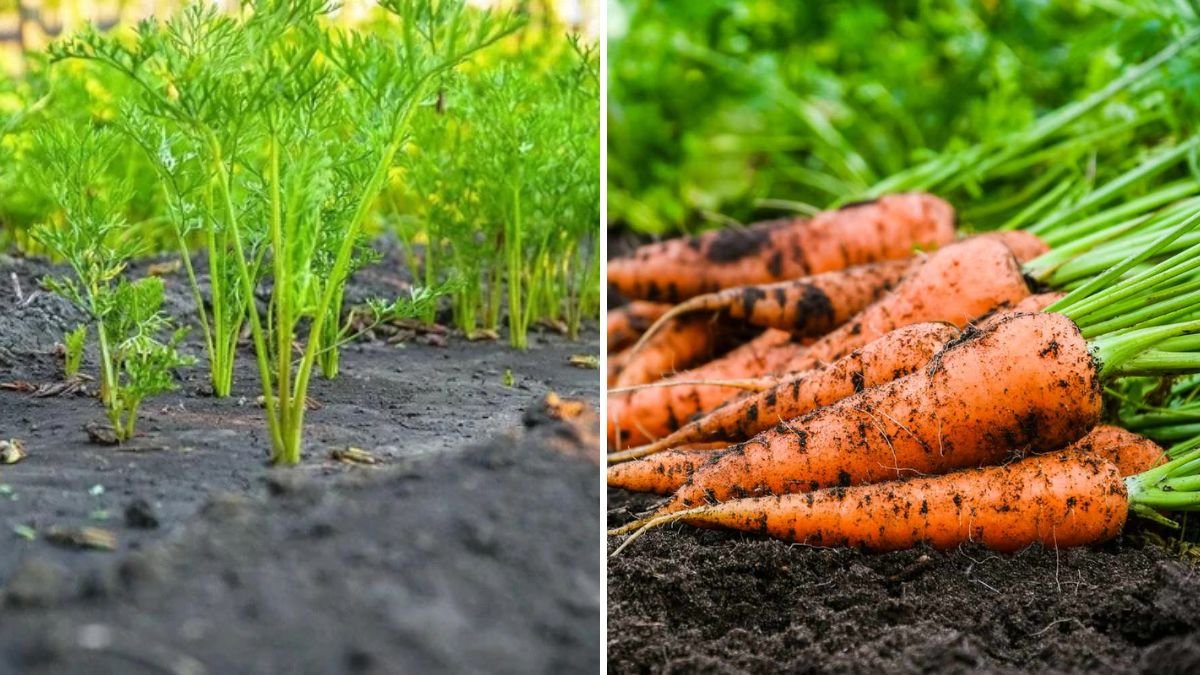Carrots (Daucus carota) are among the most popular and nutritious root vegetables grown worldwide. They are rich in beta-carotene, fiber, antioxidants, and essential vitamins, making them a staple in healthy diets. Growing carrots in containers offers a practical solution for urban gardeners, balcony growers, and those with limited outdoor space. Container gardening allows for better control of soil quality, moisture, and sunlight, which are essential for producing healthy, straight, and flavorful roots.
This article provides a comprehensive 6-step guide to growing carrots in containers, covering everything from selecting varieties and preparing containers to caring for plants and harvesting.
Step 1: Choosing the Right Carrot Variety
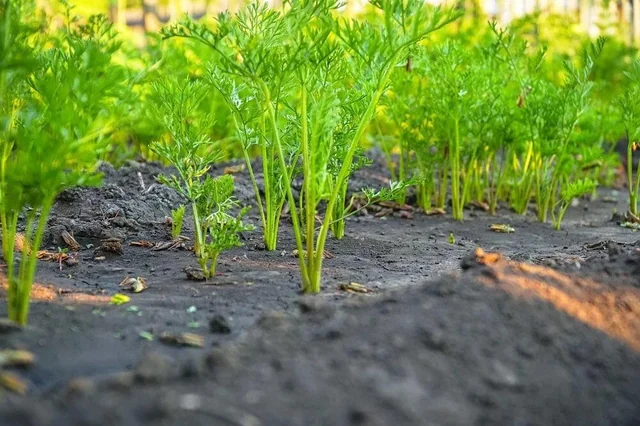
Selecting the appropriate carrot variety is critical for successful container cultivation.
- Container-Friendly Varieties:
- Short or “thumb” carrots like ‘Paris Market’ or ‘Thumbelina’ are ideal for small containers.
- Medium-length varieties such as ‘Danvers’ or ‘Nantes’ are suitable for deeper containers.
- Flavor and Color Options:
- Traditional orange varieties are widely popular, while purple, yellow, and white carrots provide unique flavors and visual appeal.
- Maturity Time:
- Choose varieties based on your desired harvest period. Early-maturing carrots typically take 60–70 days, while standard varieties may take 80–90 days.
- Disease Resistance:
- Look for varieties resistant to common diseases like carrot root fly, leaf blight, or fungal infections.
Selecting the right variety ensures compatibility with container depth and space, producing high-quality carrots efficiently.
Step 2: Selecting and Preparing Containers
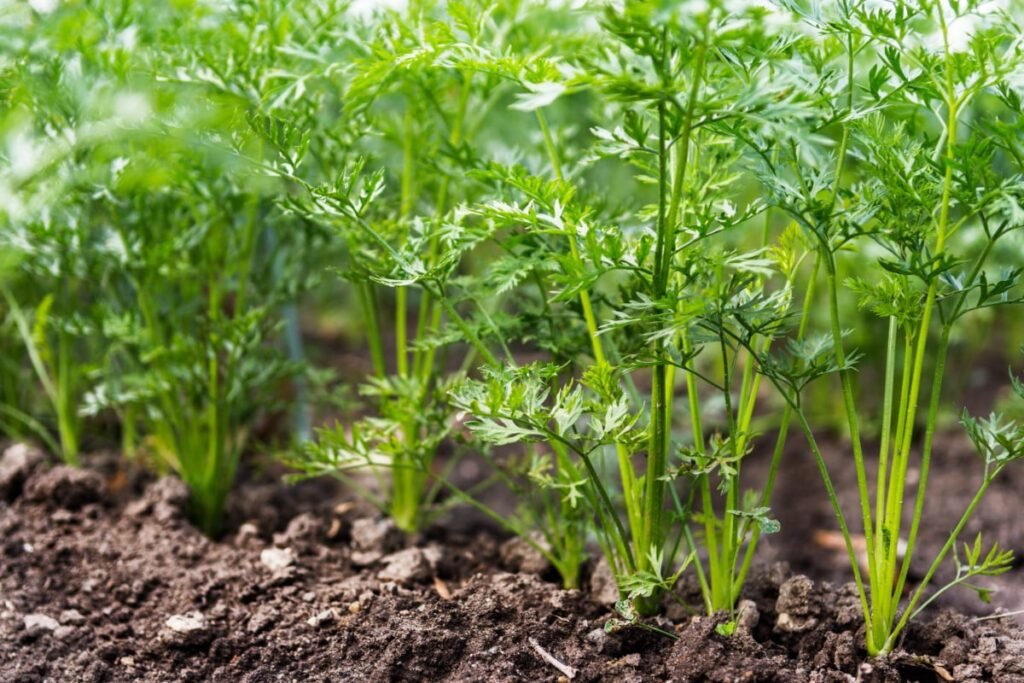
Container choice is a crucial factor for root development and overall plant health.
- Container Size:
- Carrots require at least 12 inches of depth for proper root growth.
- Wider containers allow more plants and better airflow.
- Material:
- Terracotta pots provide good aeration but dry out quickly, while plastic containers retain moisture longer.
- Ensure the container is durable and suitable for outdoor or indoor use.
- Drainage:
- Drill or ensure existing holes for proper drainage to prevent waterlogging and root rot.
- Mobility:
- Lightweight pots or containers with wheels make it easier to move plants to optimize sunlight exposure.
Choosing the right container promotes straight, healthy root growth and prevents common container gardening problems.
Step 3: Preparing the Soil
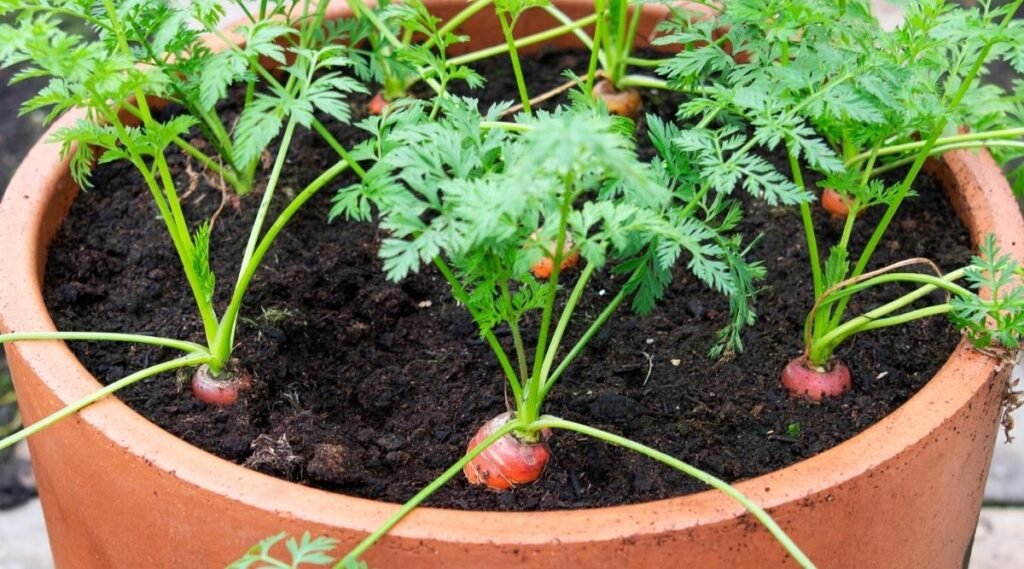
Proper soil preparation is essential for carrots because they are root vegetables and sensitive to soil conditions.
- Soil Composition:
- Use loose, well-draining soil rich in organic matter.
- Mix potting soil with compost or well-rotted manure for nutrients.
- Soil Texture:
- Avoid heavy clay soils that can impede root growth and lead to forked or stunted carrots.
- Sandy loam or light potting mix works best.
- pH Level:
- Maintain a slightly acidic to neutral pH of 6.0–6.8.
- Soil Depth:
- Ensure the container has at least 12 inches of soil depth for medium-length carrots, and deeper for long varieties.
- Fertilization:
- Avoid high-nitrogen fertilizers, which promote foliage over root development.
- Use balanced organic fertilizers or compost to support steady growth.
Well-prepared soil creates the ideal environment for carrots to grow straight, flavorful roots.
Step 4: Sowing Carrot Seeds
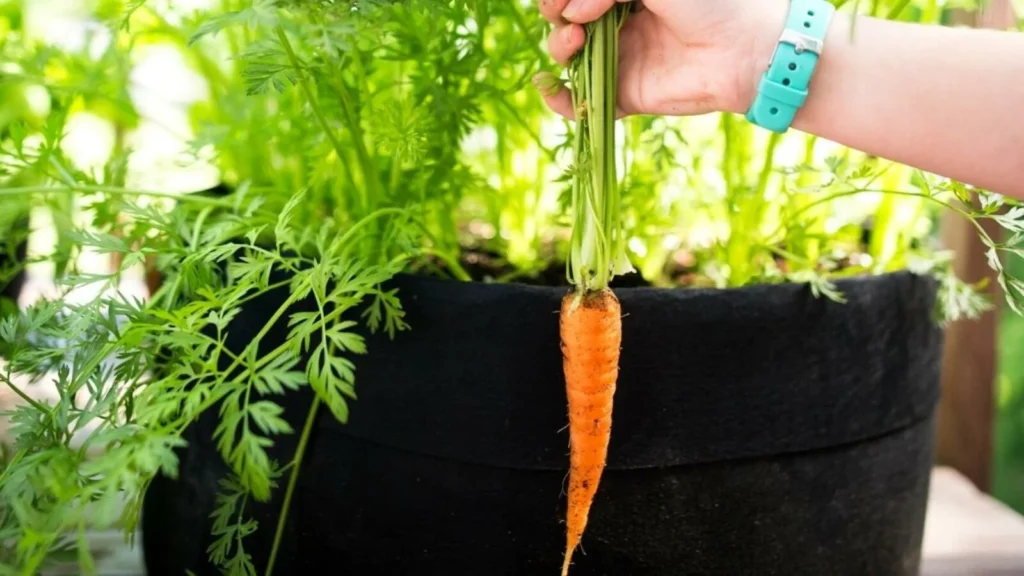
Carrot seeds require careful sowing because of their small size and slow germination.
- Seed Preparation:
- Mix seeds with fine sand to help distribute them evenly while sowing.
- Soak seeds for 2–3 hours to improve germination rates.
- Sowing Technique:
- Sow seeds directly in containers ¼–½ inch deep.
- Space seeds thinly to prevent overcrowding.
- Watering:
- Mist the soil gently to avoid displacing seeds.
- Keep soil consistently moist until germination.
- Germination Time:
- Carrot seeds typically germinate in 10–20 days, depending on temperature and soil conditions.
- Thinning Seedlings:
- Once seedlings are 2–3 inches tall, thin them to 2–3 inches apart to allow adequate room for root growth.
Proper sowing and thinning ensure optimal root development and prevent stunted or misshapen carrots.
Step 5: Caring for Carrots in Containers
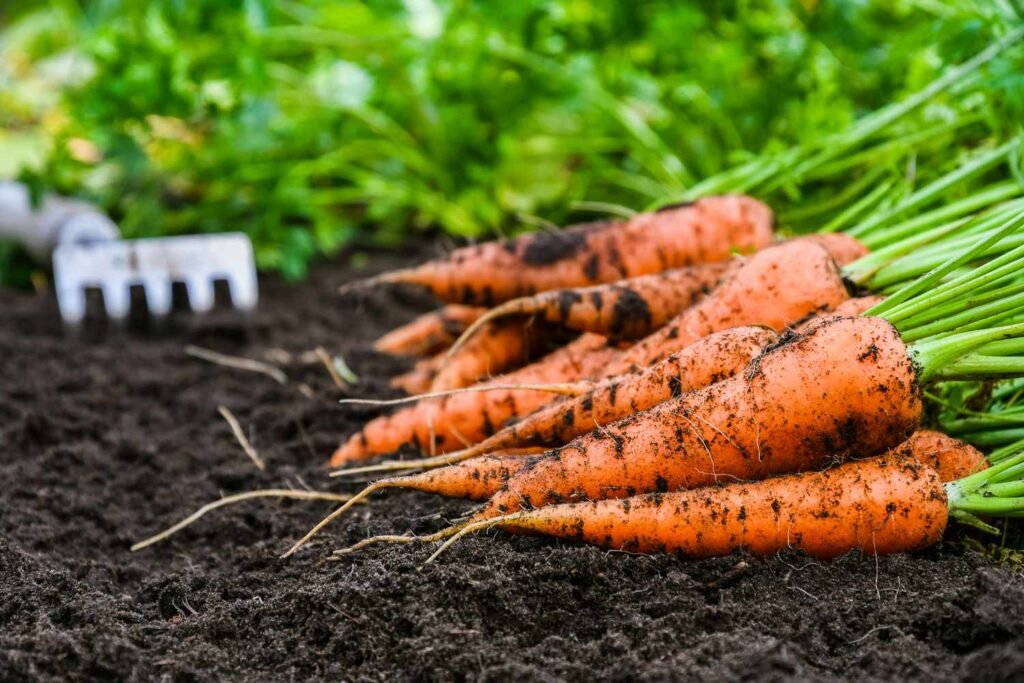
Maintaining the right conditions and regular care ensures healthy carrot growth and high yields.
- Watering:
- Carrots need consistent moisture but should not sit in waterlogged soil.
- Water deeply once or twice a week, depending on temperature and container size.
- Fertilization:
- Apply a balanced organic fertilizer or compost tea every 3–4 weeks.
- Avoid over-fertilizing with nitrogen, which can cause excessive foliage growth.
- Mulching:
- Apply a thin layer of organic mulch to retain soil moisture, regulate temperature, and suppress weeds.
- Sunlight:
- Carrots need 6–8 hours of sunlight daily.
- Place containers in a sunny balcony, windowsill, or use grow lights if indoors.
- Pest and Disease Control:
- Common pests include carrot root fly, aphids, and nematodes.
- Use natural remedies such as neem oil, insecticidal soap, or companion planting (e.g., onions or marigolds) to repel pests.
- Ensure good airflow and avoid overwatering to prevent fungal infections.
Consistent care throughout the growth period ensures healthy roots, vibrant foliage, and high-quality harvests.
Step 6: Harvesting and Storage
Harvesting carrots at the right time maximizes flavor, nutrition, and overall yield.
- Harvest Timing:
- Carrots are typically ready to harvest 60–90 days after sowing, depending on the variety.
- Check root size by gently pulling one carrot to assess maturity.
- Harvesting Technique:
- Loosen the soil around the roots before pulling to avoid breaking the carrots.
- Pull carefully from the base to keep roots intact.
- Post-Harvest Care:
- Remove foliage immediately to prevent moisture loss from roots.
- Wash gently and store in a cool, dry place or refrigerator.
- Continuous Harvest:
- Succession planting every few weeks ensures a continuous supply of fresh carrots throughout the season.
Proper harvesting and storage maintain the quality, flavor, and shelf-life of homegrown carrots.
Additional Tips for Container Carrot Gardening
- Succession Planting: Sow small batches of seeds every 2–3 weeks for a continuous harvest.
- Companion Planting: Grow carrots with onions, garlic, or lettuce to deter pests and enhance growth.
- Avoid Root Damage: Handle carrots carefully during thinning and harvesting to prevent bruising.
- Rotate Containers: Avoid planting carrots in the same soil repeatedly to reduce disease build-up.
Implementing these tips improves productivity and ensures a successful container carrot garden.
Benefits of Growing Carrots in Containers
- Space Efficiency: Ideal for urban spaces, balconies, and patios.
- Control Over Soil: Enables customization of soil type, drainage, and nutrients.
- Chemical-Free Produce: Grow organic carrots without pesticides or synthetic fertilizers.
- Year-Round Gardening: Indoor container gardening allows for off-season carrot cultivation.
- Educational and Therapeutic: Teaches gardening skills and provides a relaxing, hands-on hobby.
Container carrot gardening combines practicality, nutrition, and sustainability, making it a rewarding project for gardeners of all levels.
Conclusion
Growing carrots in containers is a practical and enjoyable way to cultivate fresh, nutritious vegetables in limited spaces. By following these six easy steps—choosing the right variety, selecting appropriate containers, preparing soil, sowing seeds carefully, providing consistent care, and harvesting properly—you can achieve healthy, flavorful, and straight carrots right at home.
Container gardening allows urban gardeners to take control of soil, water, and sunlight conditions, resulting in higher yields and better-quality produce. With patience, attention, and regular care, anyone can grow a thriving container carrot garden, ensuring a continuous supply of nutrient-rich carrots for cooking, salads, and snacks.
Whether you are a beginner gardener or an experienced horticulturist, growing carrots in containers is an accessible, rewarding, and sustainable gardening practice that promotes healthy eating and urban green living.
